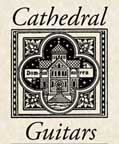 |
7/1/2008 First in a series of interviews covering players, composers and builders of multi-string guitars. 1 | 2 |
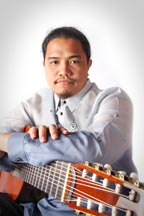 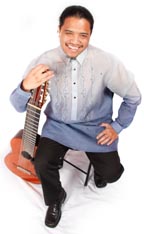 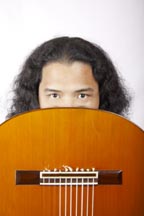 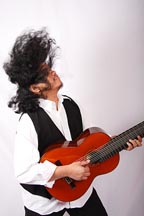 |
1) CG: Did you come from a musical family? What kind of music was played at home during your early years? *** PDC: The mother's side of my family is more musical. My mother used to play piano, virtuosic pieces like Chopin and Rachmaninoff and she did school recitals. My uncles also played piano and guitar. They also used to love to sing. We had records: Mozart, Bach, Jesus Christ Superstar, Sesame Street, assorted 45s. Guitar is a more or less permanent fixture in Filipino family life, there's always somebody who played guitar and he's the one who accompanied singers during get-togethers and parties... this was before karaoke machines! That said, I do believe that I'm the first in the family that
went on to pursue a career in Music, all my siblings are now
lawyers in the Philippines. 2) CG: Was guitar your first instrument? Was there one in the house, or how did you first start learning to play? Were you drawn specifically to the guitar, or more to music-making in general? *** PDC: My first "instrument" was a ping pong paddle! I found photos of me at age 5 in a cowboy outfit holding a ping pong paddle and strumming it like a guitar! I took piano lessons as a kid as well and I remember not liking it. We had a piano in the house but not a guitar. The turning point was my 2nd year in high school: the music
teacher challenged the class to learn at least one instrument
for the school year and I chose guitar. Once I started lessons,
off I went. 3) CG: Was your first guitar a nylon- or steel-string guitar? What kind of music did you first play on it? *** PDC: It was a nylon-string guitar and I signed up for classical guitar lessons.... for no other reason than I was young and didn't know any better. Fortunately I had a pretty good understanding of musical notation prior to my guitar lessons; the school I attended at the time had a good music teacher. I learned classical guitar pieces. IIRC, I was learning the Sor Bm study and the Chilesotti "Saltarello" before I switched over to electric guitar. However, I was picking on some chords and rock tunes at the
same time as well. I remember R.E.M's "The One I love"
as the first song I ever learned. 4) CG: Do I understand you to say that you abandoned the classical guitar for some time to concentrate on electric? What brought you back to the classical guitar, and how did you first encounter the 10-string? *** PDC: Well, yeah! I was 13 at the time (1988) and I wanted
to rock out! I convinced my mom to buy me an electric guitar
maybe 6-7 months after I started guitar lessons. Electric guitar
became my focus for the next 10 years or so.... eventually I
started teaching guitar in the music school I went to at age
15, got in my first major band at 19, released records, Classical guitar had always been in the background, I'd pick it up from time to time during my electric days. With the rock scene dying down, I decided to go back to music
conservatory and get my Bachelor's degree. That's when I met
Jose Valdez, who not only rekindled my love for classical guitar;
he also introduced me to the 10-String Guitar. I auditioned for
him prior to enrollment and I remember him pulling out that 10
string and playing something for me.... it I first acquired a 10-string in 1999 and it lived in its case
for several months. Finally I just decided to sell my 6 string
classical and focus on learning 10-string full-time. 5) CG: Do you think that your experience playing rock music has given you some skills that make you a better classical musician? Improvising is making a small comeback in classical music, and that is certainly something that I'm sure you are good at. Do you improvise or compose original music on the 10-string? *** PDC: If anything, my background in classical music helped my rock playing. With lead guitar, one usually thinks in single lines just like a horn and string player. Learning classical guitar and theory opened my ears up and allowed me to pay attention to counterpoint. This helped me immensely in songwriting, song arrangement and record production. Possibly the biggest thing my rock background brings to my classical playing is the freedom of expression. I can take a piece and play it differently every single time according to my mood or disposition at the time. This "fly by the seat of my pants" approach keeps things interesting -- it might work great but it also has the possibility of crashing and burning! Of course my interpretations are still educated according to style, era and affect, and I try to work within those boundaries. Playing and jamming out with bands and different people also helped me develop a good sense of ensemble playing. As far as the improvisational aspect goes, I guess it helps my classical playing that I can improvise -- I can make something up on the fly if I forget a musical passage! Once in a while, I devote a practice session to just improvising
and searching for new sounds/possibilities on the 10-string.
I have some sketches and ideas for compositions but nothing concrete
yet. I'll have to sit down one of these days and flesh them out. 6) CG: A question about your former teacher, Jose Valdez: was he a student of Narciso Yepes -- or how did he become acquainted with the 10-string guitar in the Philippines? Also, is your tuning system from Maestro Valdez, or is this something you came up with on your own? *** PDC: You know, I should interview him about it when I visit the Philippines. I'm not entirely sure how he came to play the 10 string. Perhaps he saw Yepes in concert when the Maestro stopped by in Manila. I doknow that Yepes is considered an equal of Segovia in the Philippines. Valdez' standard tuning is as follows: 10 - F (1st fret 6th string) And he has a variety of tunings depending on the key and style of music he's playing. For dropped D pieces, he would lower the 6th string to D and tune the 7th string up to E. The 7th string can be retuned down to low AA. The other extra strings can also be retuned depending on what other basses may be need according to a piece. For the most part, his use of the 10 string is meant to enhance the playability and interpretation of 6 string pieces, not necessarily extend that music's range. Another reason for his tuning may be the unavailability of the thicker strings in the Philippines. When I started out, I first adopted his tuning system. Then eventually started keeping my 7th string tuned to low BB, something I'm comfortable with from playing 7-string electric. When I moved to the US, I decided to keep my 7th to D and tune the 8th down to low AA. I had to re-learn most of my repertoire in this tuning and started learning new music on it. I feel that this tuning is a good compromise between the different 10 string tunings out there: a)I have the lower range of the Romantic tuning After concertizing with this tuning, I've found out that I
rarely need to change tunings to go from piece to the need. I
can program standard and dropped-D tuned pieces in a set and
keep a good flow of the program. If I do re-tune, it's mostly
kept to the 9th and 10th strings. 7) CG: What kinds of reactions do you get from people who see your concerts, and experience the 10-string guitar for the first time? Is there an interest more in the instrument, or are people more focused on your artistry, performance and the music? *** PDC: Well, I think the instrument piques the audience
interest initially then the music sustains that interest throughout
the performance. That said, the audience members I talk with
after a concert usually say good things about the music and performance
first before mentioning the instrument. 8) CG: Popular interest in any instrument depends on having both great performers and also new compositions, specifically for the instrument. Have you had any opportunities to speak with composers, and if so, how interested are they in composing for the 10-string guitar? *** PDC: Yes, I've corresponded with composers. The interest
to write for 10-String is definitely there, especially after
they hear me play or after I demonstrate its qualities. Rohan
Leach's "Sylph Dance" was the first work I received
from such correspondence. I have a few more works that I am learning
and I'm expecting to receive a few more. I'm particularly I believe composers who are not that familiar to the guitar
are more inclined to write for 10-string. Since they are not
used to writing within the range of a normal 6 string, they can
write music that will exploit the 10-string's extended range.
Sometimes this means coming up with new techniques to play some
passages and I find that process exciting. 9) CG: Your latest CD has a strong component of Filipino music. Do you plan on continuing to introduce music from your homeland to USA audiences? *** PDC: Yes, Filipino music will always be part of my repertoire.
It's always well-received despite being unfamiliar to most audiences.
Aside from being an interesting part of my repertoire, my playing
of Filipino music allows me to be in touch with my roots. It
reaffirms where I come from and how I wish for my audience to
perceive me: I am a 10) CG: Do you have any advice for people who might be interested in taking up the 10-string? What kind of learning curve should they expect? *** PDC: Probably the best advice to give is that they should come to the instrument with an open mind and try to imagine all the possibilities. Perhaps the best candidates are people who are unsatisfied with the 6 string and are looking to expand their musical palette. That said, I don't believe the 10-string is a graduation from the 6-string, meaning one shouldn't feel the need to "master" the 6-string before taking up 10-string. Technique-wise, the difficulty mainly lies with the right hand. One needs to work on opening up the right hand so the thumb can extend and reach the extra basses. A minor tweak in the guitar holding angle is also need since the strings are shifted lower than that of a 6 string; this can be corrected by either raising the footstool setting or by using a guitar support like the Ergoplay. The sharper neck angle eases the bend in the left hand wrist. More important than technique is a good understanding of music theory, harmony and counterpoint. This will help the player get the most musical use of the instrument's capabilities and not just throw in the random low note to "justify" having the extra strings. ********** PERFECTO DE CASTRO - 10 String Guitarist ********** |
|
